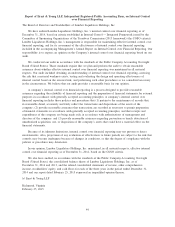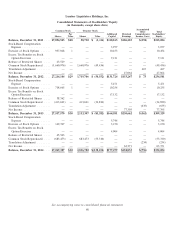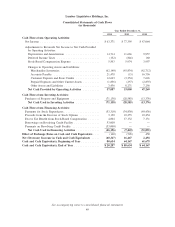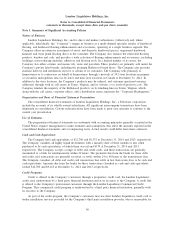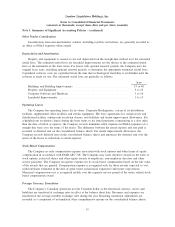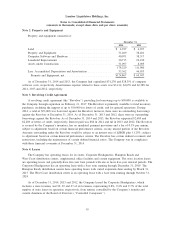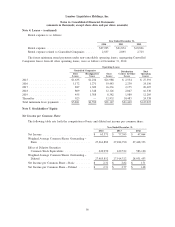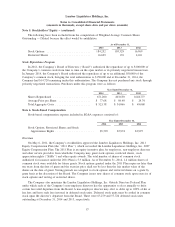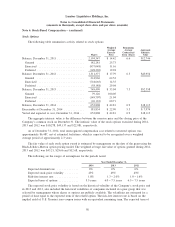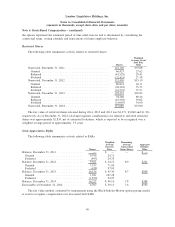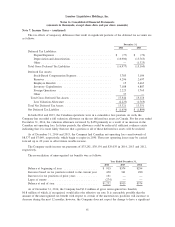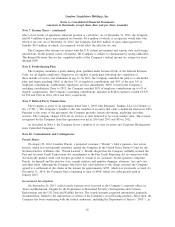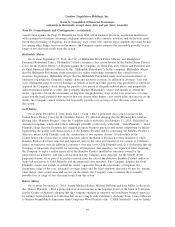Lumber Liquidators 2014 Annual Report Download - page 62
Download and view the complete annual report
Please find page 62 of the 2014 Lumber Liquidators annual report below. You can navigate through the pages in the report by either clicking on the pages listed below, or by using the keyword search tool below to find specific information within the annual report.Lumber Liquidators Holdings, Inc.
Notes to Consolidated Financial Statements
(amounts in thousands, except share data and per share amounts)
Note 1. Summary of Significant Accounting Policies − (continued)
Income Taxes
Income taxes are accounted for in accordance with FASB ASC 740 (‘‘ASC 740’’). Income taxes are
provided for under the asset and liability method and consider differences between the tax and financial
accounting bases. The tax effects of these differences are reflected on the consolidated balance sheets as
deferred income taxes and measured using the effective tax rate expected to be in effect when the differences
reverse. ASC 740 also requires that deferred tax assets be reduced by a valuation allowance if it is more likely
than not that some portion of the deferred tax asset will not be realized. In evaluating the need for a valuation
allowance, the Company takes into account various factors, including the nature, frequency and severity of
current and cumulative losses, expected level of future taxable income, the duration of statutory carryforward
periods and tax planning alternatives. In future periods, any valuation allowance will be re-evaluated in
accordance with ASC 740, and a change, if required, will be recorded through income tax expense in the
period such determination is made.
The Company recognizes the tax benefit from an uncertain tax position only if it is more likely than not
that the tax position will be sustained on examination by the relevant taxing authorities, based on the technical
merits of its position. The tax benefits recognized in the financial statements from such a position are
measured based on the largest benefit that has a greater than 50% likelihood of being realized upon ultimate
settlement. The Company classifies interest and penalties related to income tax matters as a component of
income tax expense.
Net Income per Common Share
Basic net income per common share is determined by dividing net income by the weighted average
number of common shares outstanding during the year. Diluted net income per common share is determined
by dividing net income by the weighted average number of common shares outstanding during the year, plus
the dilutive effect of common stock equivalents, including stock options and restricted shares. Common stock
and common stock equivalents included in the computation represent shares issuable upon assumed exercise
of outstanding stock options and release of restricted shares, except when the effect of their inclusion would
be antidilutive.
Recent Accounting Pronouncements
In May 2014, the FASB issued Accounting Standards Update No. 2014-09 (‘‘ASU 2014-09’’), which
creates ASC Topic 606, Revenue from Contracts with Customers, and supersedes the revenue recognition
requirements in Topic 605, Revenue Recognition, including most industry-specific revenue recognition
guidance throughout the Industry Topics of the Codification. In addition, ASU 2014-09 supersedes the cost
guidance in Subtopic 605-35, Revenue Recognition — Construction-Type and Production-Type Contracts, and
creates new Subtopic 340-40, Other Assets and Deferred Costs — Contracts with Customers. In summary, the
core principle of Topic 606 is that an entity recognizes revenue to depict the transfer of promised goods or
services to customers in an amount that reflects the consideration to which the entity expects to be entitled in
exchange for those goods or services. The amendments in ASU 2014-09 are effective for annual reporting
periods beginning after December 15, 2016, including interim periods within that reporting period, and early
application is not permitted. Therefore, the amendments in ASU 2014-09 will become effective for the
Company at the beginning of its 2017 fiscal year. The Company is currently assessing the impact of
implementing the new guidance on its consolidated financial statements.
54


